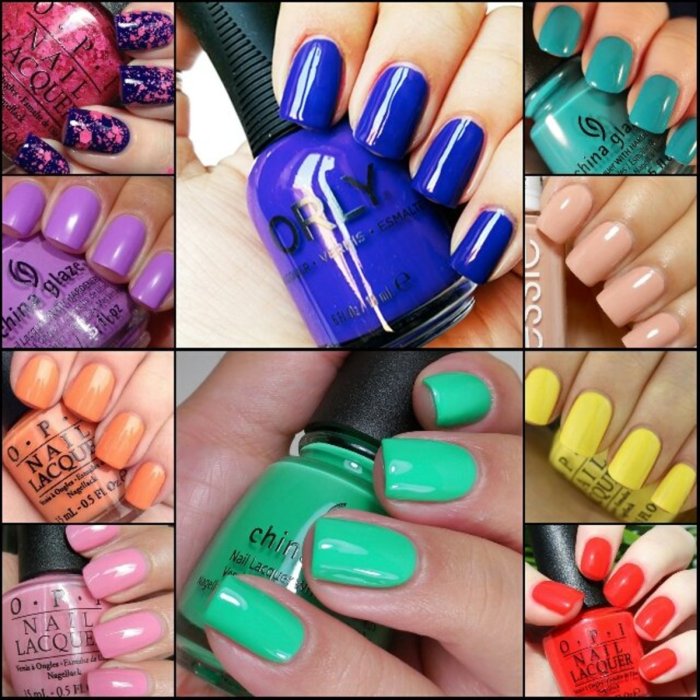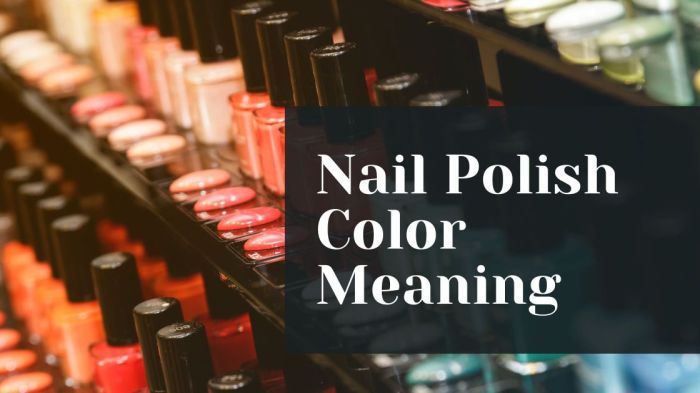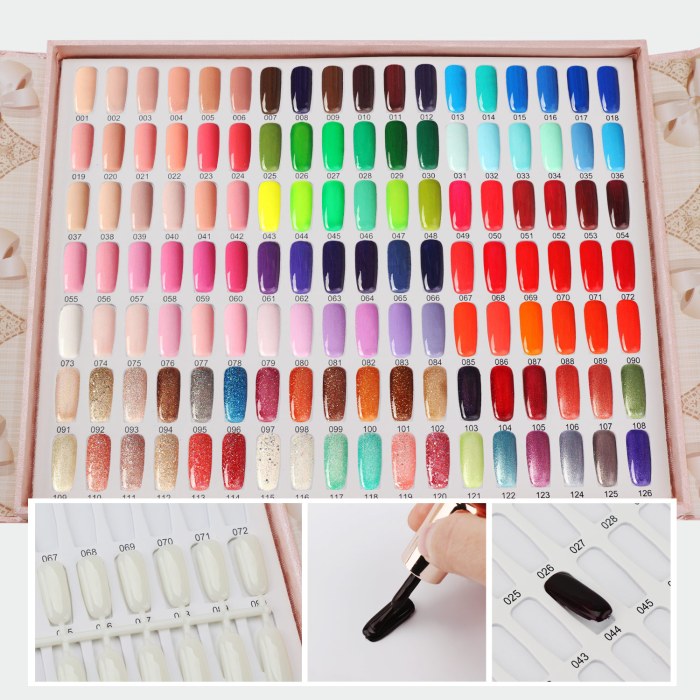Color of Nail Polish Meaning A Comprehensive Guide
Cultural Significance of Nail Polish Colors: Color Of Nail Polish Meaning
Color of nail polish meaning – Nail polish color choices transcend mere aesthetics; they often carry deep cultural significance, reflecting societal norms, historical trends, and individual identity. The symbolism associated with specific colors varies dramatically across different cultures, shaping social interactions and perceptions.
Variations in Nail Polish Color Across Cultures
Cultural interpretations of nail polish colors are diverse. In some East Asian cultures, for example, pale, natural tones are favored, reflecting ideals of modesty and refinement. Conversely, vibrant reds and golds are frequently seen in South Asian cultures, signifying festivity, celebration, and prosperity. Western cultures exhibit a broader range of acceptance, with color choices influenced by fashion trends and personal expression.
Historical Context of Nail Polish Color Symbolism
Historically, the use and meaning of nail polish have evolved. In ancient Egypt, for instance, darker shades were popular among the elite, signifying status and wealth. The introduction of commercially produced nail polish in the 20th century brought about a wave of new color options and associated meanings, influenced by fashion and popular culture.
Social Implications of Nail Polish Color Choices

Source: saymedia-content.com
Choosing a particular nail polish color can have significant social implications. A bright red manicure might be interpreted as bold and confident in some settings, but inappropriate in others. Similarly, muted tones might be viewed as professional and understated in a business environment, while a more adventurous color palette could be perceived as less suitable. The context significantly shapes the interpretation.
Comparative Table: Symbolic Meanings of Nail Polish Colors
| Color | Western Culture | East Asian Culture | South Asian Culture |
|---|---|---|---|
| Red | Passion, energy, confidence | Good fortune, celebration (often associated with weddings and festivals) | Good luck, prosperity, festivity |
| Pink | Femininity, sweetness, playfulness | Youthfulness, innocence (less prominent than red) | Love, romance (often used in wedding celebrations) |
| Blue | Calmness, serenity, sophistication | Harmony, peace (often associated with nature) | Loyalty, trust (less frequently used than red or pink) |
Psychological Interpretations of Nail Polish Colors
Color psychology suggests that nail polish color choices can reveal aspects of an individual’s personality and emotional state. The associations we make with colors are often deeply ingrained and can subconsciously influence our decisions.
Psychological Associations with Nail Polish Colors, Color of nail polish meaning
Red is often linked to passion, excitement, and confidence. Black can symbolize mystery, power, or rebellion. Pastel shades are frequently associated with gentleness, calmness, and femininity. These are broad generalizations, and individual interpretations can vary significantly.
Influence of Color Psychology on Nail Polish Choices
Color psychology plays a role in our unconscious choices. If someone is feeling bold and assertive, they might gravitate towards a vibrant red or deep purple. Conversely, someone feeling stressed might opt for calming pastels or neutral tones. This connection isn’t always conscious but reflects a subconscious desire for self-expression.
Nail Polish Colors Reflecting Personality and Mood
A person’s nail polish color can offer clues about their personality and mood. Someone who consistently chooses bright, attention-grabbing colors might be extroverted and expressive, while someone who prefers muted tones may be more introspective and reserved. It’s important to remember that these are generalizations and should not be used for definitive personality assessments.
Survey Assessing Correlation Between Nail Polish Preference and Personality
A short survey could explore the link between nail polish color preference and personality. Questions might include: “What is your favorite nail polish color?”, “How would you describe your personality?”, and “What colors do you typically wear in your clothing?”. Analyzing responses could provide insights, but it’s crucial to acknowledge limitations and avoid overgeneralization.
Nail Polish Color Trends and Their Meanings
Nail polish color trends evolve over time, reflecting broader societal shifts in fashion, culture, and aesthetics. The meaning associated with specific colors can remain consistent, change subtly, or even undergo a complete transformation.
Current and Past Trends in Nail Polish Colors
Over the past two decades, we’ve seen trends ranging from the dominance of classic reds and French manicures to the rise of bold, jewel-toned shades and the popularity of minimalist nude tones. The 2010s saw a surge in bright, neon colors, while recent years have embraced more natural and sophisticated palettes.
Comparing and Contrasting Symbolic Meanings of Trends
The meaning of a color can shift within the context of a trend. For example, while red has traditionally signified passion, its use in a minimalist manicure might convey a sense of understated elegance rather than overt boldness. Similarly, the meaning of nude shades has evolved from a symbol of understated simplicity to a representation of modern sophistication and self-assured minimalism.
Chronological Evolution of Nail Polish Color Meanings
The evolution of nude shades illustrates this point well. In the early 2000s, nude shades were primarily associated with a natural, almost “barely there” look. However, in recent years, nude shades have become increasingly diverse, ranging from creamy beiges to sophisticated rose golds, reflecting a more sophisticated and individualized approach to beauty.
The Impact of Nail Polish Color on Personal Branding and Self-Expression
Nail polish color choices contribute significantly to personal branding and self-expression. The colors we choose can communicate aspects of our personality, style, and professional image, consciously or unconsciously influencing how others perceive us.
Nail Polish Color and Personal Branding Strategies
In professional settings, a carefully chosen nail polish color can enhance a personal brand. For instance, a lawyer might opt for classic neutral tones to project professionalism and competence, while a fashion designer might choose bolder colors to showcase creativity and individuality. The choice should align with the desired image.
Using Nail Polish Color to Express Personal Style and Identity
Individuals use nail polish as a form of self-expression, reflecting their unique style and personality. Someone with a vibrant, eclectic style might choose bright, mismatched colors, while someone with a more minimalist aesthetic might opt for understated shades or a simple French manicure.
The color of your nail polish can be a fun way to express your personality, but it’s important to consider nail health too. Choosing shades you love shouldn’t compromise your nails; it’s worth noting that improper application or prolonged use of certain polishes might contribute to issues, so it’s helpful to understand if something like can nail polish cause nail fungus.
Ultimately, maintaining healthy nails allows for greater creative freedom with nail polish color choices.
Role of Nail Polish Color in Different Professional Settings
The appropriateness of nail polish color varies across professions. While a fashion stylist might be free to express themselves through bold color choices, a surgeon might need to adhere to stricter guidelines for hygiene and professionalism, opting for neutral or clear polishes.
Mood Board Illustrating Nail Polish Color and Personal Branding
A mood board for a fashion stylist’s personal branding might include images of runway looks featuring bold colors, close-ups of intricately designed nail art, and examples of stylish, colorful clothing. This would visually communicate the stylist’s creative and expressive approach to fashion.
Nail Polish Color and Occasion
The appropriateness of nail polish color depends heavily on the occasion. Certain colors are considered more suitable for formal events, while others are better suited for casual settings. Understanding these nuances can help create a cohesive and appropriate overall look.
Nail Polish Color Choices for Specific Occasions

Source: paintingspider.com
Weddings often call for more delicate and elegant shades, such as soft pinks, nudes, or light pastels. Funerals generally require more subdued colors, like dark blues or grays. Formal events may be suited to classic reds or sophisticated metallics. Casual settings allow for greater freedom of expression.
Appropriateness of Nail Polish Colors for Different Social Contexts
A bright, neon color might be perfectly acceptable at a music festival but inappropriate at a job interview. Similarly, a classic red manicure can be elegant for a formal dinner but might feel too bold for a quiet afternoon tea.
Enhancing or Detracting from an Overall Look

Source: segbeauty.com
Careful consideration of nail polish color can enhance an outfit and overall appearance. A well-chosen color can complement an outfit’s colors and style, creating a harmonious and polished look. Conversely, a poorly chosen color can clash with the outfit, detracting from the overall impression.
Appropriate Nail Polish Colors for Different Occasions
- Weddings: Soft pinks, nudes, light pastels, shimmering neutrals. These colors convey elegance and sophistication, complementing the celebratory mood.
- Funerals: Dark blues, grays, deep purples. These subdued colors demonstrate respect and solemnity.
- Formal Events: Classic reds, metallics, deep jewel tones. These colors project elegance and confidence.
- Casual Settings: Virtually any color is appropriate, depending on personal preference and style.
FAQ Overview
What does chipped nail polish signify?
Chipped nail polish can be interpreted in several ways, depending on context. Some may view it as a sign of neglect, while others might see it as a casual, lived-in aesthetic.
Are there nail polish colors considered inappropriate for the workplace?
Highly vibrant or unconventional nail polish colors might be deemed inappropriate in some professional settings. Generally, neutral or subtly colored polishes are preferred in more conservative workplaces.
How can I choose a nail polish color that complements my skin tone?
Consider your skin’s undertones (warm, cool, or neutral) when selecting a nail polish color. Warm undertones pair well with warm colors (reds, oranges, golds), cool undertones with cool colors (blues, purples, silvers), and neutral undertones with a wider range of colors.
Can nail polish color influence mood?
While not scientifically proven, many believe that certain colors can evoke specific moods. For example, bright colors may energize, while softer shades may promote calmness.
















